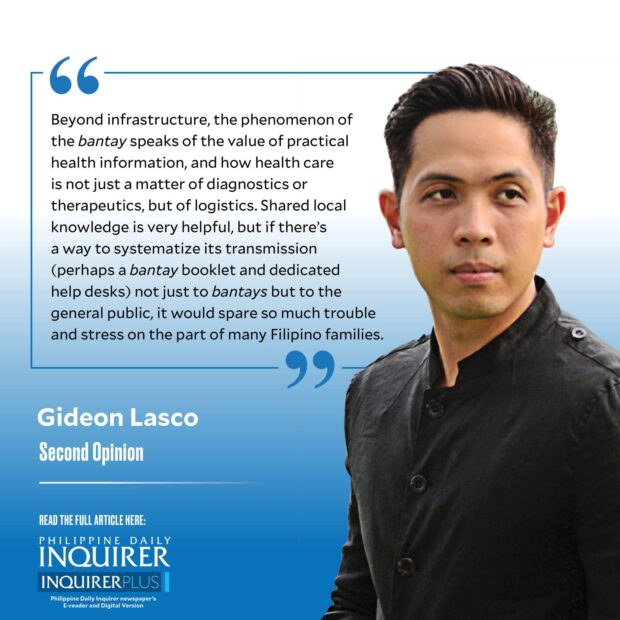
When I was doing my medical training in the Philippine General Hospital (PGH) in the late 2000s, we had what we called the “bantay system”—a state of affairs in which a charity patient’s “bantay” (customarily translated as “watcher”) not only looks after them, but also gets conscripted to do various health-care-related tasks. In an excellent blog post, Dr. Ella Mae Masayamor, an internist, offers glimpses of the system a decade later, and her notes are worth quoting at length:
“The bantay facilitates much of the patient’s schedules for X-rays, ultrasounds, ECGs, and what-have-yous. To do that, they are given request forms duly accomplished by the student-in-charge or the resident-in-charge, and they have to take that piece of paper across the maze that is PGH, moving through confusing hallways and signs. In the emergency room, bantays are also tasked to bring specimens—blood, urine, sputum samples—to the laboratory, a yet another elusive location.
“In the ward, the bantay attends to the patient 24/7. That means cleaning the patient up, attending to their wounds, and carrying the IV bottle wherever the patient goes. The bantay basically attends to the patient’s activities of daily living while in the ward. That also means the bantay actually lives in the ward. That means sleeping under the patient’s bed and sharing the same common bathroom to bathe and relieve themselves.”
The bantays are quickly socialized to the role by other more experienced bantays, who are typically happy to share their knowledge to the “neophytes.” In some barangays, there are people who are known to be experts in being a bantay and are called upon to accompany community members.
This is probably true for most hospitals, but it is magnified in a tertiary hospital like PGH for at least two reasons. First, PGH being the hospital of last resort means that people come from all over the country, and many of them are completely unfamiliar with Manila, let alone the workings of a labyrinthine hospital. Having a watcher becomes even more essential in such an unfamiliar, inhospitable environment, fraught with all kinds of fraud and opportunism.
Second, PGH being a charity hospital means that the services are at a bare minimum, and the very low health-care worker to patient ratios leads to reliance on other people—including the patients themselves and their families. Students are a big help (during my time, we did most procedures ourselves, from blood extraction to catheter insertion as the assigned “students-in-charge” for each patient) but the bantays are essential for all the tasks mentioned above, and more.
It is different, of course, if you’re in a private facility, or, within PGH itself, the top “pay floors.” Even the most well-resourced patient needs a bantay to take care of their various needs, if nothing else, to manage the stream of visitors, but at least they get to stay in private rooms.
Looking back, I found the bantays to be mostly cooperative; few complained of their conscription or their living conditions: Perhaps, more than anything else, a sign of how our people’s expectations are too low and getting admitted to PGH was already a great deal notwithstanding its far-from-ideal circumstances (lacking air conditioning, the wards can be hot and humid, and at least during our time, another role of the bantay is to look for an electric fan).
Still, we have to consider them in our thinking, if nothing, because their presence comes at a price too (think of the cost, the lost income, of people staying in hospitals all day), and their labor should serve as an additional impetus to make hospital services more efficient and to make bantays more comfortable and safe in their stay. To their credit, hospital and government officials alike are trying to address this issue and at least one bill—House Bill No. 1844 authored by Cagayan de Oro City Rep. Rufus Rodriguez—has been filed to create a “Bantay Antayan” in PGH; if successful this should be replicated in other hospitals.
Beyond infrastructure, the phenomenon of the bantay speaks of the value of practical health information, and how health care is not just a matter of diagnostics or therapeutics, but of logistics. Shared local knowledge is very helpful, but if there’s a way to systematize its transmission (perhaps a bantay booklet and dedicated help desks) not just to bantays but to the general public, it would spare so much trouble and stress on the part of many Filipino families.
Can we also think of these measures as opportunities to also promote the health of people who go to the hospital, not as patients, but as watchers, companions? Since they’re already there, they might as well get vaccination, health information, screening tests, etc.—especially since many Filipinos won’t go to a hospital on their own volition until their condition is serious.
As for what else can be done for and with them, we should let the bantay speak for themselves. Many doctors have already told their stories through essays, short stories, and poems, surely we (also) have much to learn about our health-care system, our hospitals, and ourselves from the eyes of the bantays.
—————-
glasco@inquirer.com.ph

